by Eddie Powell | May 20, 2013
Protecting new vegetable transplants in the garden can be very challenging for most gardeners.
Continue below for a few tips that will make transplanting vegetables more successful:
- Create A Collar: A collar can be made from a bottomless plastic cup or a waxed cardboard carton to protect transplant from cutworms. The collar should extend one inch above and below the surface of the ground.
- Row covers can be placed at planting to keep insects out. Remember to leave plenty of excess material for the growing vegetable plants. Remove the row cover when plants that need bees for pollination begin to flower.
- Make sure to plants stay in a continuously growing state and in a state of good health by supplying appropriate amounts of water and fertilizer. A healthy plant is more than likely going to survive an insect attack than a sick plant. However, too much fertilizer can cause plants to be more inviting to aphids and whiteflies.
- Monitor or scout the garden twice weekly for pest problems. This means inspecting the vegetable plants from both the upper and lower foliage to the soil level. It is best to keep a record book on pest problems and the performance of different varieties. Also include photographs of insects, diseases and beneficial insects. Be sure to correctly identify the insects.
- The ability to identify beneficial insects of the garden is important (praying mantis, spiders, big-eyed bugs/assassin bugs, lady beetles, and all wasps). Plant flowers in the vegetable garden that provides nectar and pollen which will attract beneficial insects.
- Most large insects like caterpillars can be removed by hand and destroyed.
- Watch for disease symptoms early and remove any diseased leaves or plants to the prevent problem from spreading. Most plants that produce fruits, pods, or ears can stand up to 20 percent loss of leaves without loss of potential yields. Do not panic and start spraying at the first sign of leaf feeding or a sick looking plant. Call or visit your local University of Florida Extension Service for recommendations on controlling any vegetable insect or disease problem.
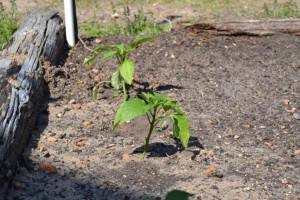
Image Credit Eddie Powell
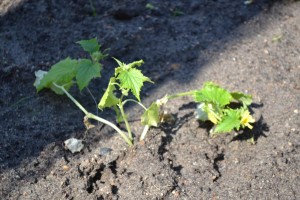
Image Credit Eddie Powell
By Eddie Powell
by Eddie Powell | Feb 15, 2013
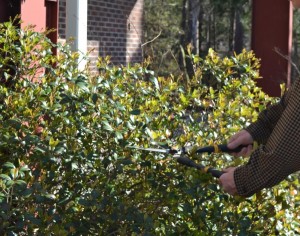
As spring approaches, many gardeners get out the pruning shears and prune everything in sight. That might not be the best course of action! Take a look at these tips for flowering landscape shrubs to learn more about pruning techniques that will maximize amount of bloom.
Why Prune?
• Control plant size or form
• Remove damage (mechanical, disease, etc.)
• Prevent potential damage (overlapping branches, poor crotch angles, diseases, etc.
• Stimulate new growth (rejuvenate old plants, fill bare areas, increase flowering, etc.)
When to prune:
• Corrective pruning due to injury or dead tissue should be done as soon as evident.
• Avoid pruning from August 15 until plants are dormant.
• Most pruning should be done during the dormant season or immediately after flowering.
Rules of thumb:
• The “May Rule”.
• May defined if the plant blooms before May 1, prune immediately after flowering has ended (flowers produced on old wood or last year’s growth: Azaleas, Forsythia, etc.)
• If the plant blooms after May 1, prune during the dormant season (flowers produced on new growth: Crape Myrtles, Lilac Chaste tree, etc.).
• As with any rule there are exceptions: Oak leaf Hydrangea.
General rules of Pruning: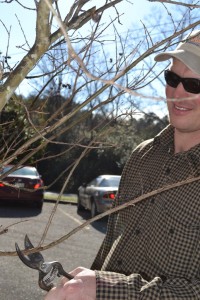
• Local in affect (usually within 6” of cut).
• Cuts should be made ¼” above a bud or to a crotch (Lateral branch).
• Cuts should be made at angles.
Pruning Equipment: (Make sure blades are sharp)
• Hand Snips (for small branches)
• Loppers (branches > 0.75” in diameter)
• Pruning Saw (limbs > 1.5” in diameter)
• Shears (for a more formal look)
• Pruning Knife (for clean-up)
Safe Pruning Principles:
• Keep equipment clean and in good repair.
• Appropriate, properly fitted safety equipment for job (eye and ear protection, no loose fitting clothes, etc.)
• Keep equipment within your control zone. Don’t over extend, know the limitations of your equipment and yourself.
• Know your surroundings (overhead utilities, other workers, etc.).
• Be able to identify Poison Ivy, Poison Oak, and other skin irritants.
Quick Tips to Remember:
• Pruning: Remove dead wood and seed pods annually during the dormant season.
• Size control should be done by cultivar selection, not by pruning.
• To promote a second set of flowers, prune away faded or spent flowers throughout the season.
For more information, click here for a UF / IFAS Extension publication on proper pruning techniques.
If you have any questions contact your local county extension agent.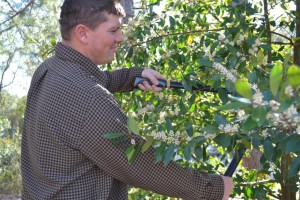
by Eddie Powell – Walton County Extension Horticulture Agent





